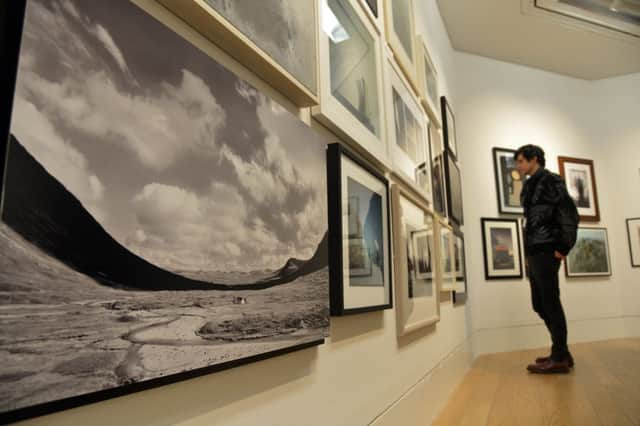Diverse and fascinating Scottish Society of Artists


Since the National Gallery took over the building, however, the SSA, the Royal Scottish Society of Painters in Watercolour and Visual Arts Scotland all accustomed to using the RSA’s rooms in the past and on their own, have had to share a single time slot in the gallery’s programme. Last year they all squeezed in at once, but it really was a crowd. So this year they are taking it in turns and putting on three separate exhibitions. They will be consecutive, albeit very brief. The RSA Open exhibition is also showing concurrently in the ground floor rooms of the building. This exhibition has open submission, but works submitted have to be within a specified and limited size; small in fact.
The SSA is first in the series in the main galleries. It runs till 20 December. That’s barely two weeks – blink and you’ll miss it. So don’t blink. It is well worth it. They have used the space of the RSA’s grand rooms very well. There is a lot in the show and it is pretty diverse stuff, but it seems neither crowded nor confused. The SSA is an open submission exhibition and has stuck to that principle, but other elements have always also been added. This year there are invited artists, invited curators and a group of invited recent graduates. A cinema has even been built to project film by eight artists or partnerships including Dalziel + Scullion.
Advertisement
Hide AdTwo recent graduates make an immediate impression in the first room. Marina Burt has an extraordinary live art work with silk worms – moths, larvae and cocoons – all getting on with life and making silk in the top drawer of a chest of drawers. She is searching for the sublime, she says. Maybe she hasn’t quite found that yet, but it is a fascinating spectacle all the same. Ryan Essen has an installation called Void. It wasn’t fully working when I saw it, but using film of wind, fire and water projected in a mirror-lined cubicle, he evidently makes the world seem to dissolve. Equally impressive and even more elaborate, ink by Nicole Heidke and Stefan Baumberger consists of a row of blue spheres like giant eyeballs. They start to spin when you approach them revealing a flickering hand-written text, white within the blue. The blue is ink and the whole thing is an elaborate soliloquy on the printed word.
Graham Fagen is an invited artist this year. Always interesting, his Scheme of Conscience doesn’t disappoint. It incorporates a set of grinning black bogles in indian ink with enamel teeth which are nominally self-portraits and an enigmatic sculpture in the form of a tree with cubes in gold, bronze and clay in place of leaves or fruit.
Members, together with artists from the open submission, also make a good showing however. Julia Douglas makes a poetic point with Keep the Fires Burning, a photograph of the gable, built with almost neolithic stones, of a ruined Highland cottage, its empty fireplace filled with flowers. Norman McBeath shows a group of restrained and eloquent photographs. The dark humour of Robert Powell’s brilliant comic prints, 16 together in a group, is a delight. David Forster’s big, eerie watercolour She lighted her lantern and went to church has a Pre-Raphaelite quality, while Christine Wylie’s etchings are elegantly minimal. Lorna Fraser’s Still is a garden shed transmogrified and filled with white, porcelain plants. Lys Hansen’s sculpture Headways, made from a piece of rough-cut tree trunk painted in vivid colours, is genuinely surreal. There is a great deal more and in addition there is a changing display of small unframed works by members, but altogether it is a very good show. So don’t blink.
Downstairs, The RSA Open suffers by comparison because with nearly 400 small works hung in a relatively small space it is bound to seem crowded. There is however much to enjoy. Josefina Ayllón’s untitled is a vivid and economical expressionist portrait. Erland Tait’s oddly titled Where do you go, young seal? is a beautiful variation on a theme from Picasso’s Blue Period. Lindsay Robertson’s Rannoch Moor, Will Collier’s Chancelot Mill and Kenneth Gray’s Empty Shop are all striking photographs. There is a bit of a surrealist theme running through the show too and Helen Flockhart’s Yellow Flowered Dress, Peter Thomson’s Conversation, Alic McMurrough’s All the Way Home and Heather Nevay’s The Murder all have a touch of true poetic strangeness about them. Fiona Dean’s The Best Shag I Ever Had, a stuffed pair of copulating birds – shags in fact – is on the other hand, a taxidermist’s pun. Hironori Katagiri’s Awakening Landscape is a more conventional piece of sculpture, a jagged window cut from stone. Smallest and almost last in the show, Halla Groves-Raines Lost is a tiny boat at sea in a tea cup – a calm in a tea cup perhaps.
Finally, the show also includes The RSA Architecture Open. It gives us a chance to see amongst other intriguing things models for Page and Park’s adaption of the grim basement of the National Galleries of Scotland building to create a new entrance and a new gallery for the Scottish collection, and Oliver Chapman Architects plans for the exciting development of the new Edinburgh Printmakers on Fountainbridge.
• SSA until 20 December. RSA until 20 January 2015